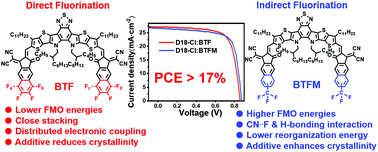Non-fullerene acceptors with direct and indirect hexa-fluorination afford >17% efficiency in polymer solar cells†
Abstract
The rational molecular design of non-fullerene acceptors (NFAs) in organic solar cells (OSCs) can profoundly influence the photovoltaic (OPV) performance. To date, NFA fluorination has proven beneficial to cell performance. However, there is a lack of comprehensive understanding of how various fluorination modalities influence film morphology, carrier mobility, molecular packing, other structural properties, electronic structure, exciton separation, and charge transport, that determine ultimate cell efficiency. Here, we compare two types of end group (EG) fluorination patterns on Y6-based A-DAD-A cores, resulting in highly efficient NFAs: direct skeletal fluorination (BTF) and indirect trifluoromethyl fluorination (BTFM). These two patterns induce distinctive behaviors in the active layer blends with a chlorinated donor polymer D18-Cl and the additive, 1-chloronaphthalene, affording high PCE values of 17.30% (BTF + additive) and 17.10% (BTFM, no-additive). The BTFvs.BTFM OSC performance trends can be correlated with diffraction-derived differences in molecular packing. Density functional theory (DFT) reveals remarkably low internal reorganization energies and high electronic coupling between NFA dimers, greater and more numerous than in other NFAs reported to date, thus providing extended 3D charge transport networks in the thin film crystalline domains. Transient absorption spectroscopy reveals that hole transfer from the acceptor to the donor occurs in <300 fs and that photoexcited carriers persist for hundreds of ns in each blend film. The contrasting role of the additive in BTF and BTFM cells is further clarified by recombination dynamics analysis using in situ photocurrent and impedance spectroscopy. Overall, this work provides guidance for developing new NFAs via direct and indirect fluorination strategies for high efficiency OSCs.

- This article is part of the themed collection: Energy & Environmental Science Recent HOT Articles


 Please wait while we load your content...
Please wait while we load your content...
